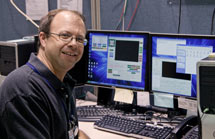
Handy Links
SLAC News Center
SLAC Today
- Subscribe
- Archives: Feb 2006-May 20, 2011
- Archives: May 23, 2011 and later
- Submit Feedback or Story Ideas
- About SLAC Today
SLAC News
Lab News
- Interactions
- Lightsources.org
- ILC NewsLine
- Int'l Science Grid This Week
- Fermilab Today
- Berkeley Lab News
- @brookhaven TODAY
- DOE Pulse
- CERN Courier
- DESY inForm
- US / LHC
SLAC Links
- Emergency
- Safety
- Policy Repository
- Site Entry Form

- Site Maps
- M & O Review
- Computing Status & Calendar
- SLAC Colloquium
- SLACspeak
- SLACspace
- SLAC Logo
- Café Menu
- Flea Market
- Web E-mail
- Marguerite Shuttle
- Discount Commuter Passes
-
Award Reporting Form
- SPIRES
- SciDoc
- Activity Groups
- Library
Stanford
Around the Bay
Automated Beamline Messages Give SSRL Users a Break
Some users of the Stanford Synchrotron Radiation Lightsource enjoyed a little extra peace of mind, as well as more regular meals and sleep, starting in early spring of 2010. That's when Sam Webb gave them a software tool that kept an eye on their experiments for them.
"Users would joke that it'd be nice if the beamline could call them," said Webb, an SSRL staff scientist and beamline support scientist. "I said, 'Well, technically that's not that hard to do.'"
Webb's software tracks data collection, as well as the status of the SPEAR synchrotron accelerator, and notifies both users and Webb himself via text message or e-mail if something out of the ordinary occurs. Webb installed it on Beamline 2-3, the dedicated microfocus imaging beamline, as well as Beamline 10-2, which is run half-time in imaging mode. During this past run the messaging tool was offered as an option for users on Webb's beamlines.
"If anything weird happens—if the ring dumps, or data collection gets stuck somewhere—it'll see that and send an e-mail or text message" to the user, Webb explained. The messaging tool will also notify users when the accelerator comes back online if there's been a break in service.
"Quite often, if the ring dumps, a user will go get dinner," Webb said. "When they come back they realize the ring's been up for half an hour and they've wasted half an hour of time. So actually [the tool] lets you know when you should be heading back to the beamline, too."
"The real advantage is for people who can actually leave the beamline and get rest or get dinner," Webb said. He explained that this is often the case with imaging because the software enables users to automate much of the data gathering process.
Does this tool have any downsides? "Standard text messaging rates may apply," Webb said with a laugh.
According to Webb, development and implementation of the tool have thus far been on an informal basis. One problem proved to be ensuring adequate testing and debugging. Of the users who did request that the tool be turned on, Webb said most did not receive messages because nothing went wrong. The solution was for Webb himself to, as he put it, "mess things up" during test beam time.
"I got lots of messages," he said. After Webb made the tool available to his users, he did get some feedback from them as well.
"It was a great help," said Weili Zheng, a post-doctoral researcher working for Professor Helen Nichol, an SSRL user from the University of Saskatchewan. "We didn't need to get up at midnight and worry about whether the data collection was going properly." Another benefit, said Zheng, was that the messaging tool freed them up for other tasks, such as data analysis. "It made our work much more efficient."
Webb plans to add "Messaging Tool 1.0" to the user interface of the data collection software he wrote for his beamlines, and to expand the tool's messaging capabilities based on user feedback. For example, users have asked to be messaged when a scan has completed so they can return to the station to set up another scan. He expects to roll out the tool to other beamlines, as well.
Better safe than sorry. "Personally I hate being at the beamline all night myself," Webb said. He grinned. "It's always best if users have sleep."
—Lori Ann White
SLAC Today, September 16, 2010
